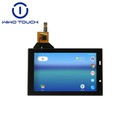Resistive touchscreen technology relies on electrodes that layer a uniform voltage across the entire conductive area. This provides a specific voltage reading when an area of the two years make contact.
The type of resistive layout determines the durability and sensitivity of the entire circuit.

4-Wire Analog
In a 4-wire analog setup, both the top and bottom layers contain two electrodes called “bushbars”.
These electrodes are oriented perpendicular to one another.
Electrodes on the top sheet are the positive and negative Y axis, while electrodes on the bottom are the positive and negative X axis.
Using this sort of electrical-coordinate setup, the mobile device can sense the coordinates where the two layers have come in contact.
5-Wire Analog
A 5-wire analog setup consists of four electrodes placed at each corner of the bottom layer. There are four wires that connect these electrodes together.
The fifth wire is the “sensing wire” embedded into the top layer.
When your finger or stylus makes any area of the two layers touch, the sensing wire sends the voltage for the coordinates to the processor.
With fewer components and a simpler design, the 5-wire analog circuit is considered to be a bit more durable than other designs.
8-Wire Analog
The most sensitive resistive screen design is that of the 8-wire sensing circuit.
The layout is similar to the 4-wire analog, but each of the bar electrodes contain two wires. This introduces a bit of redundancy into the circuit.
This is because even if one of the wire pairs loses resistance over time, the second wire provides a secondary signal to the processor.
This means that a more expensive resistive touchscreen with an 8-wire analog circuit will last longer. It also avoids the “drift” problems older phones used to have when trying to sense the location of your finger or stylus.




